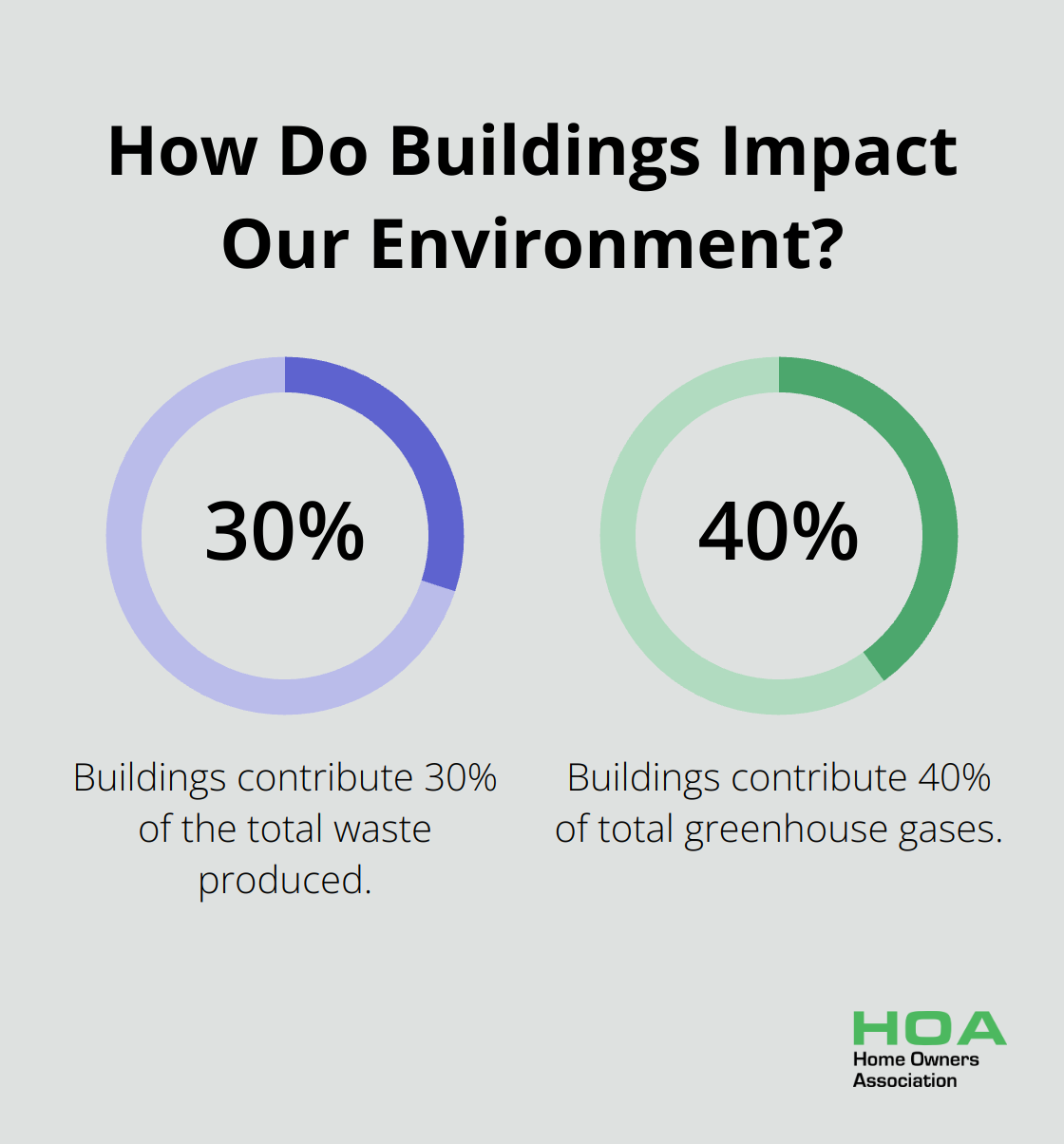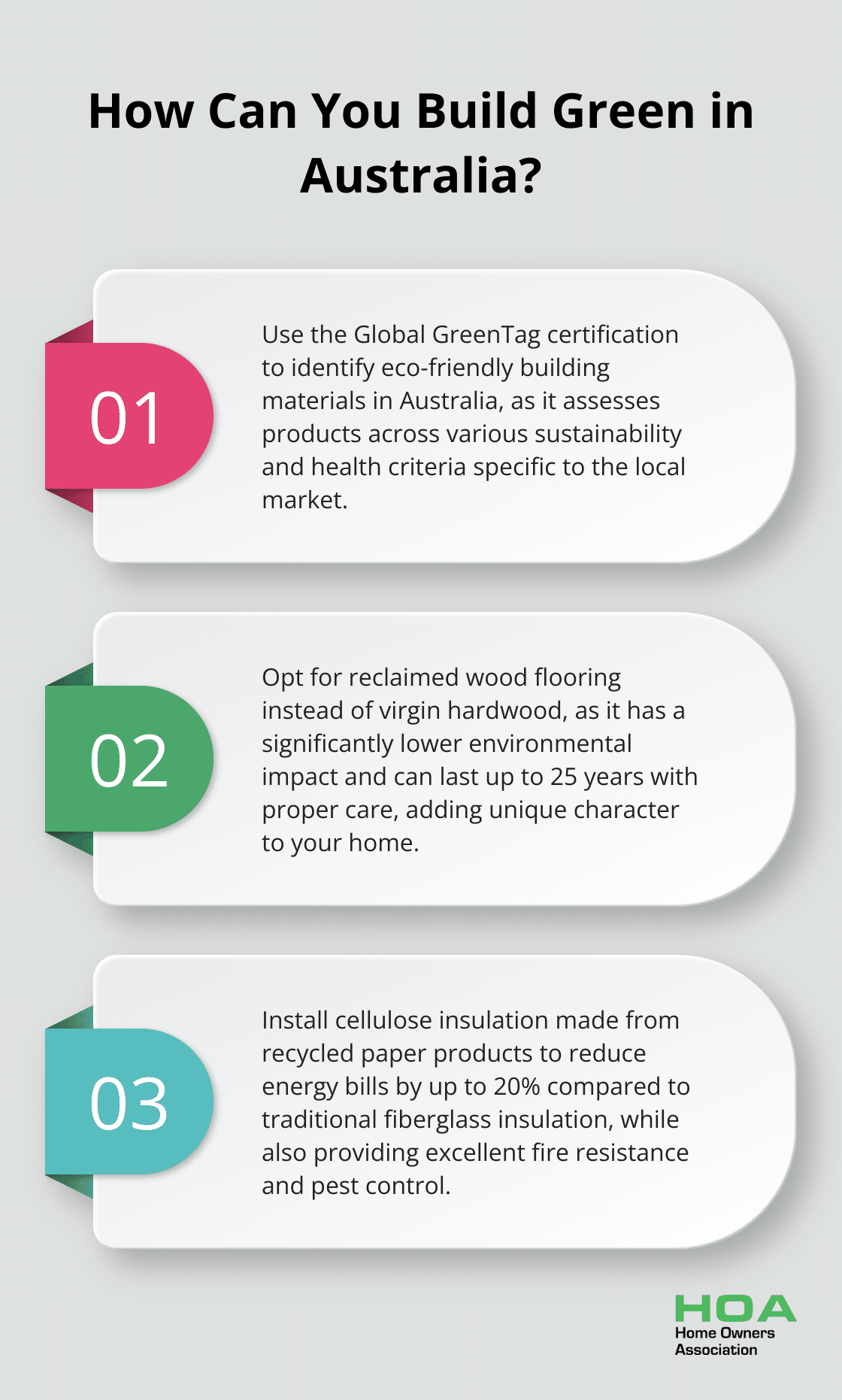
At Home Owners Association, we understand the growing importance of sustainable construction practices. Building materials play a crucial role in reducing environmental impact and creating healthier living spaces.
This guide will help you navigate the world of eco-friendly building materials, from understanding their key characteristics to selecting the best options for your project. We’ll explore popular sustainable materials and provide practical tips for making informed choices that balance sustainability with practicality and budget considerations.
What Are Eco-Friendly Building Materials?
Definition and Importance
Eco-friendly building materials are products that minimize environmental impact throughout their lifecycle. These materials are sourced, manufactured, and disposed of in ways that conserve natural resources, reduce pollution, and promote sustainability.

Buildings contribute as much as 30% of the total waste produced and as much as 40% of total greenhouse gases. Residential construction makes up the biggest portion of this impact, highlighting the importance of eco-friendly building materials in sustainable construction.
Key Characteristics to Look For
When selecting eco-friendly building materials, consider products that exhibit the following characteristics:
- Renewable or recycled content: Materials made from rapidly renewable resources (like bamboo) or recycled content (such as reclaimed wood) reduce the demand for virgin resources.
- Low embodied energy: This refers to the total energy required to produce, transport, and install a material. For example, locally sourced stone typically has lower embodied energy than imported alternatives.
- Durability and longevity: Materials that last longer require less frequent replacement, reducing waste and resource consumption over time.
- Non-toxic composition: Eco-friendly materials should not contain harmful chemicals that can off-gas and negatively impact indoor air quality.
- Energy efficiency: Materials that provide good insulation or thermal mass can significantly reduce a building’s energy consumption.
Environmental Certifications and Labels
Environmental certifications and labels simplify the process of selecting eco-friendly building materials by providing third-party verification of a product’s sustainability claims.
Some reputable certifications to look for include:
- Forest Stewardship Council (FSC): This certification ensures that wood products come from responsibly managed forests.
- Green Seal: This label indicates that a product meets rigorous standards for environmental responsibility and performance.
- ENERGY STAR: While primarily known for appliances, this certification also applies to building materials (like windows and insulation).
- Cradle to Cradle: This certification evaluates products based on material health, material reutilization, renewable energy use, water stewardship, and social fairness.
- Global GreenTag: An Australian certification that assesses products across various sustainability and health criteria.
The Australian Building Codes Board is currently developing a National Building Product Assurance Framework, which aims to improve building product compliance with the National Construction Code (NCC) and reduce the risk associated with non-compliant products.
Choosing eco-friendly building materials not only reduces your environmental footprint but also creates healthier living spaces. These materials can potentially save money through improved energy efficiency and durability. As we face ongoing environmental challenges, making informed choices about building materials becomes increasingly important for sustainable development.
In the next section, we’ll explore some popular eco-friendly building materials and their specific applications in construction projects.
Popular Eco-Friendly Building Materials
At Home Owners Association, we’ve observed a significant increase in the use of eco-friendly building materials across Australia. These materials reduce environmental impact and offer unique benefits in durability, energy efficiency, and indoor air quality.
Reclaimed Wood and Bamboo
Reclaimed wood adds character to homes while reducing environmental impact. This material, often sourced from old buildings or fallen trees, requires minimal processing and helps preserve forests. Research indicates that reclaimed framing lumber and wood flooring have a significantly lower environmental impact than their virgin alternatives.

Bamboo, a rapidly renewable resource, grows up to 91 cm per day. It boasts a tensile strength comparable to steel, making it an excellent choice for flooring, furniture, and even structural elements. Bamboo flooring can last up to 25 years with proper care, outperforming many traditional hardwood options.
Recycled Metal and Plastic
Recycled metal (particularly steel and aluminum) has become increasingly popular in construction. The Steel Recycling Institute states that steel recycling saves enough energy to power about 18 million households for a year. Recycled steel maintains its strength and durability, making it an excellent choice for structural components.
Recycled plastic finds its way into various building applications, from insulation to decking materials. Recycled plastic lumber can last up to five times longer than traditional wood decking and requires virtually no maintenance. It resists insects, rot, and moisture, making it ideal for outdoor applications.
Natural Insulation Materials
Natural insulation materials like sheep’s wool, cellulose, and cork gain traction in the Australian market. Some common eco-friendly insulation materials include glasswool, polyester, sheep’s wool, cellulose, and earthwool. Sheep’s wool insulation absorbs and releases moisture without losing its insulating properties, helping to regulate indoor humidity levels. It also resists fire naturally and can absorb airborne pollutants, improving indoor air quality.
Cellulose insulation, made from recycled paper products, has a high R-value per inch, making it an efficient insulator. Non-toxic borate compounds treat it, providing excellent fire resistance and pest control. The Cellulose Insulation Manufacturers Association reports that cellulose insulation can reduce energy bills by up to 20% compared to traditional fiberglass insulation.
Low-VOC Paints and Finishes
Low-VOC (Volatile Organic Compound) paints and finishes maintain good indoor air quality. Traditional paints can off-gas harmful chemicals for years after application, but low-VOC options significantly reduce this risk. The Green Building Council of Australia states that using low-VOC paints can reduce indoor air pollution by up to 90%.
Water-based polyurethane finishes offer an excellent alternative to traditional solvent-based options. They dry faster, have lower odor, and release fewer harmful emissions. These finishes suit hardwood floors particularly well, offering durability comparable to solvent-based products while being more environmentally friendly.
When selecting eco-friendly building materials, consider their entire lifecycle (from production to disposal). We recommend consulting with local suppliers and contractors who specialize in sustainable building practices. They can provide valuable insights into the best eco-friendly materials for your specific project and climate conditions. As we move forward, let’s explore the factors to consider when selecting these materials to ensure you make the most informed and sustainable choices for your building project.
Factors to Consider When Selecting Eco-Friendly Materials
Durability: The Long-Term Perspective
Durability stands as a key factor in sustainable building. Materials that last longer reduce the need for replacements, which minimizes waste and resource consumption over time. Fiber cement siding, for example, can last up to 50 years, while vinyl siding typically lasts 20-30 years. This longevity results in fewer replacements and less waste over a building’s lifetime.
Energy Efficiency: Beyond Initial Costs
Energy efficiency is another critical consideration. Materials that provide superior insulation or thermal mass can significantly reduce a building’s energy consumption. Structural insulated panels (SIPs) minimize heat transfer resulting in excellent thermal performance and reduced heat loss. This reduction translates to substantial long-term savings on energy bills.
Local Availability: Reducing Transportation Impacts
Sourcing materials locally supports the local economy and reduces transportation-related emissions. The embodied energy of locally sourced materials is typically lower than that of imported alternatives. Using locally quarried stone instead of imported marble can reduce transportation-related carbon emissions by up to 80%.
Budget Considerations: Balancing Cost and Value
Eco-friendly materials may have higher upfront costs, but they often provide better value over time. Metal roofing can be initially more expensive than asphalt shingles, but its longer lifespan makes it a cost-efficient choice in the long run. Additionally, many eco-friendly materials qualify for rebates or tax incentives, which further offset initial costs.

When evaluating costs, it’s essential to consider the entire lifecycle of the material, including maintenance, energy savings, and potential health benefits. Low-VOC paints might cost 10-20% more than standard paints but can significantly improve indoor air quality, potentially reducing health-related expenses over time.
Expert Advice and Support
Navigating the complexities of material selection can be challenging. Expert advice can help you make choices that align with both your sustainability goals and budget constraints. Some organizations (such as Home Owners Association) offer trade pricing and discounts on many eco-friendly building materials, making sustainable choices more accessible.
The cheapest option upfront isn’t always the most cost-effective over time, especially when it comes to eco-friendly building materials. Careful consideration of durability, energy efficiency, local availability, and budget will lead to informed decisions that contribute to a more sustainable built environment while potentially saving money in the long run.
Final Thoughts
Eco-friendly building materials offer numerous benefits, including reduced environmental impact, improved indoor air quality, and enhanced energy efficiency. These materials, such as reclaimed wood, recycled metals, and natural insulation, significantly decrease carbon footprints and create healthier living spaces. The selection of building materials (eco-friendly options) requires careful evaluation of durability, energy efficiency, local availability, and budget constraints.

Homeowners who prioritize sustainability in construction and renovation projects contribute to a greener future while potentially saving money long-term. Every choice matters, and even small steps towards eco-friendly building can have a significant cumulative impact on the environment. The Home Owners Association provides valuable support for those looking to make sustainable choices in Melbourne.
Home Owners Association offers access to trade pricing, discounts on eco-friendly materials, and expert advice to help members navigate the complexities of sustainable building. We encourage everyone to embrace the opportunity to build and renovate with the planet in mind, creating better homes for ourselves and a healthier world for future generations.





